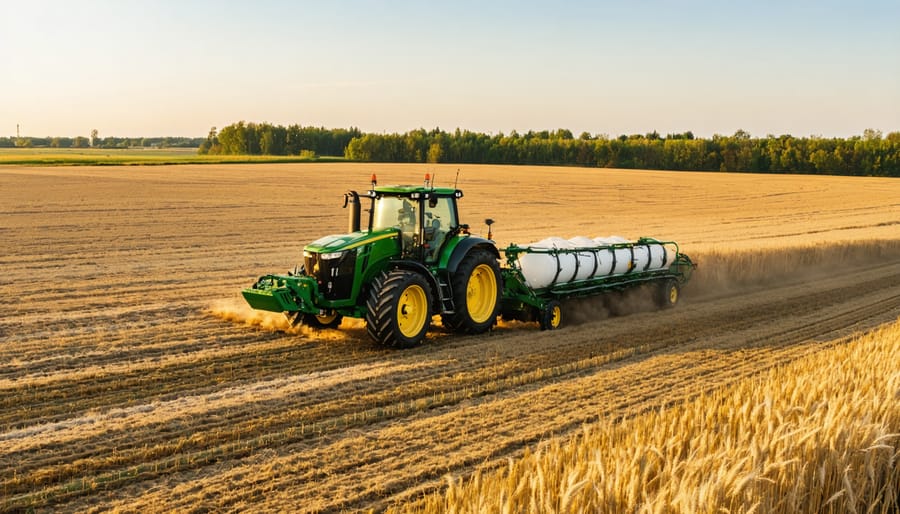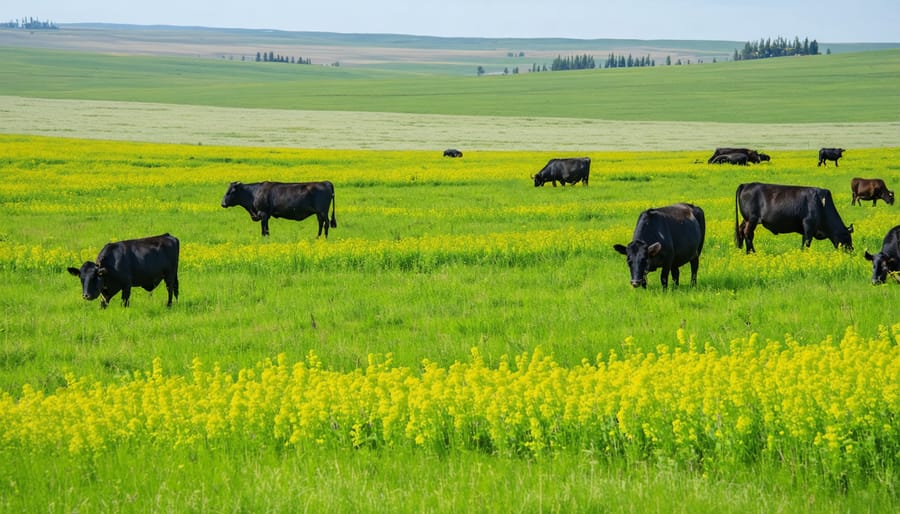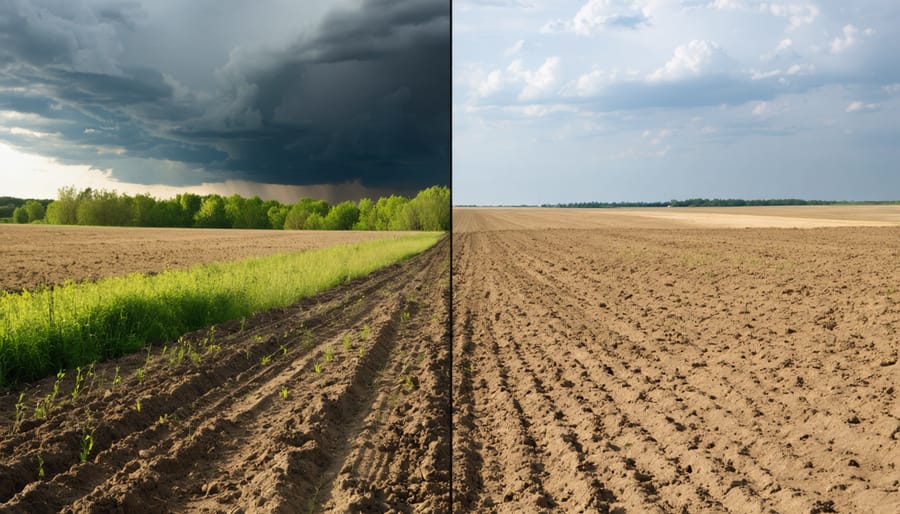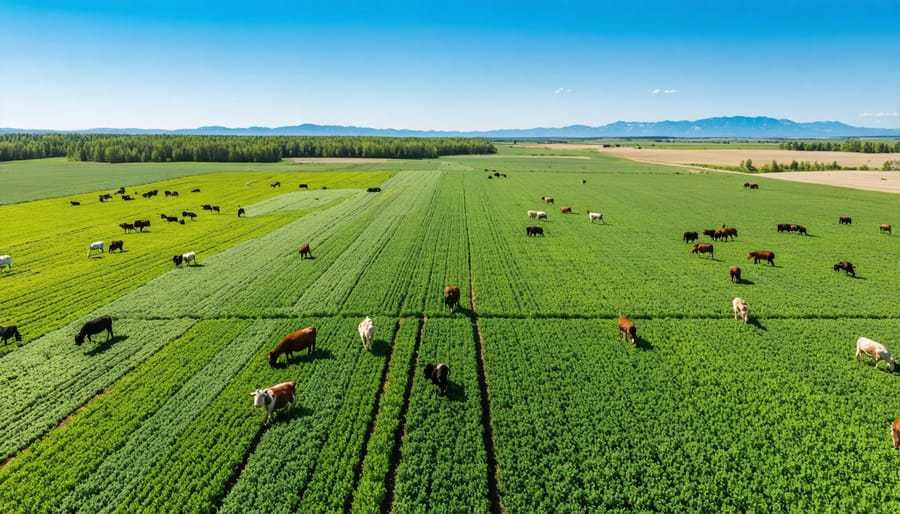Sustainable biodiversity stands as the cornerstone of resilient agricultural systems across Alberta’s diverse landscapes, where each farm represents a vital ecosystem supporting countless species. Recent studies from Agriculture Canada show that farms implementing biodiversity practices see up to 30% higher yield stability and demonstrate stronger resistance to climate fluctuations. From the rich black soil zones of central Alberta to the prairie grasslands of the south, Canadian farmers are pioneering innovative approaches that merge profitable agriculture with biodiversity conservation.
The integration of sustainable biodiversity practices isn’t just an environmental imperative—it’s a smart business decision. Alberta farmers who maintain diverse crop rotations, preserve natural habitats, and support beneficial insect populations report reduced input costs and improved long-term soil health. These practices create robust agricultural systems that can withstand pest pressures, extreme weather events, and market volatility while supporting the complex web of life that makes farming possible.
As we face increasing environmental challenges, maintaining biodiversity within our agricultural systems becomes critical for both food security and ecological stability. This practical approach to farming not only preserves our natural heritage but also ensures the continued viability of Canadian agriculture for generations to come.
The Business Case for Biodiversity on Your Farm
Natural Pest Control: Your Free Farm Workers
Nature provides some of the most effective pest control solutions, and best of all – they’re free! On Alberta farms, beneficial insects like ladybugs, praying mantises, and parasitic wasps work tirelessly to keep pest populations in check. A single ladybug can consume up to 5,000 aphids in its lifetime, protecting your crops without any chemical inputs.
Birds are also valuable allies in pest management. Tree swallows and purple martins can catch thousands of flying insects daily, while hawks and owls help control rodent populations that might otherwise damage crops and stored grain. Many local farmers have found that installing bird boxes and maintaining hedgerows not only attracts these helpful species but also reduces pest control costs by 30-50%.
Diverse plant communities support these natural pest controllers. By incorporating native flowering plants along field edges and maintaining natural areas, you create habitat for beneficial insects and birds while establishing a sustainable ecosystem that manages itself. Local farmer Mike Thompson from Red Deer notes, “Since we started maintaining natural areas on our farm five years ago, we’ve cut our pesticide use in half while maintaining yields.”
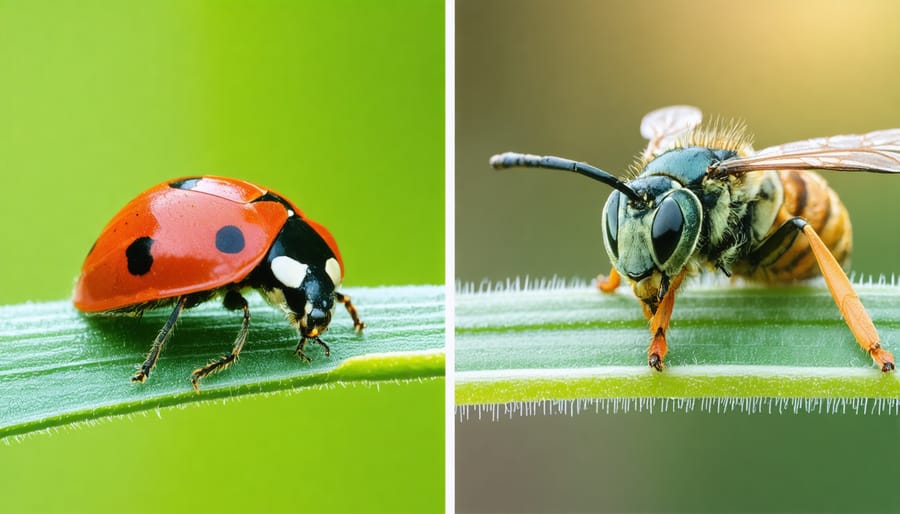
Soil Health: The Hidden Profit Center
Healthy soil isn’t just a foundation for crops – it’s a thriving ecosystem that can significantly boost your farm’s bottom line. When soil biodiversity flourishes, it creates a natural cycle of nutrient recycling, water retention, and pest management that can reduce input costs while increasing yields.
Research from Alberta’s agricultural stations shows that farms implementing soil regeneration practices have seen up to 20% increase in water retention and 30% reduction in fertilizer needs. These improvements come from the complex interactions between soil microorganisms, beneficial insects, and plant roots.
Consider the earthworm – each hectare of healthy soil can contain up to 2 million of these natural tillers, providing free soil aeration and nutrient cycling worth an estimated $400 per year. Similarly, mycorrhizal fungi networks help crops access nutrients more efficiently, potentially reducing phosphorus applications by 25%.
By viewing soil as a living system rather than just a growing medium, farmers can tap into nature’s own productivity enhancers while building long-term resilience into their operations.

Practical Biodiversity Strategies for Alberta Farms
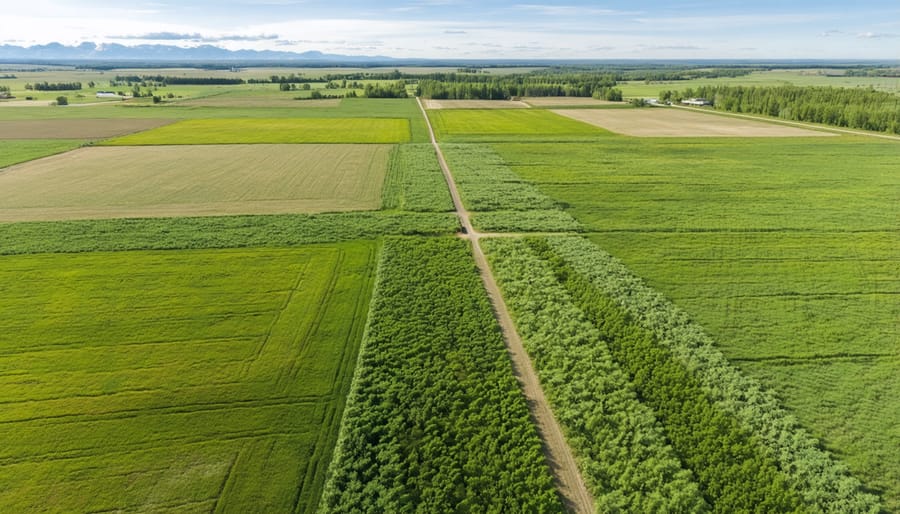
Field Margin Management
Field margins are valuable spaces that can transform your farmland into thriving wildlife corridors while supporting your main crops. By dedicating just 3-5 metres along field edges to native vegetation, you can create essential habitat connections that benefit both wildlife and your farming operation.
In Alberta’s agricultural landscape, well-managed field margins act as natural pest control zones. Local farmers report seeing increased populations of beneficial insects like ladybugs and ground beetles, which help control crop-damaging pests. These margins also provide shelter for pollinators, potentially improving yield in crops like canola.
To establish effective field margins, start by identifying existing natural features like tree lines or waterways. Plant a mix of native grasses, wildflowers, and shrubs suited to your local conditions. Popular choices include rough fescue, golden rod, and wild rose – all hardy species that thrive in Alberta’s climate.
Maintenance is straightforward but crucial. Mow margins once annually in late fall after bird nesting season, and avoid spraying herbicides in these areas. Consider leaving some sections unmowed each year to provide winter shelter for wildlife.
Many Alberta farmers have found that field margins actually improve their bottom line by reducing erosion, improving water retention, and decreasing pest control costs. Plus, these wildlife corridors contribute to your farm’s overall sustainability story, which increasingly matters to consumers and certification programs.
Crop Rotation Planning
Planning your crop rotation is like orchestrating a symphony where each crop plays a vital role in supporting biodiversity. Here in Alberta, successful farmers have found that thoughtful rotation not only improves soil health but also creates diverse habitats for beneficial insects and wildlife.
Start by dividing your fields into three to four sections, rotating through different crop families. Include a mix of cereals, legumes, and oilseeds, with each bringing unique benefits to your soil and local ecosystem. For example, follow canola with wheat, then field peas, allowing at least two years between similar crops to break pest and disease cycles.
Consider incorporating cover crops during shoulder seasons. Red clover and fall rye are excellent choices for Alberta’s climate, providing shelter for beneficial insects while improving soil structure. These “green bridges” maintain habitat continuity throughout the year.
Local farmer Mike Thompson from Lacombe shares, “Since implementing a diverse rotation including flowering crops like alfalfa, I’ve seen more pollinators and beneficial insects on my land. My yields have actually improved because of better pest control.”
Include buffer strips between fields using native prairie grasses and flowering plants. These zones create corridors for wildlife movement and serve as permanent habitat for beneficial insects. Remember to time your operations to avoid disturbing nesting birds and pollinator activity during peak seasons.
Keep detailed records of your rotations and observe changes in wildlife presence. This information helps refine your approach and demonstrates the positive impact of your biodiversity efforts.
Water Feature Integration
Water features play a vital role in supporting biodiversity on Alberta farms, and implementing effective water management strategies can create thriving ecosystems while benefiting crop production. Creating or maintaining natural ponds, wetlands, and seasonal drainage areas provides essential habitat for local wildlife, from beneficial insects to migratory birds.
Consider integrating dugouts with gentle slopes and native vegetation along the edges, which allows safe access for wildlife while preventing erosion. These features can double as irrigation reserves during dry periods, offering practical farm benefits alongside ecological advantages.
Many Alberta farmers have found success with constructed wetlands that filter runoff while supporting diverse species. For example, the Thompson family farm near Red Deer maintains a series of connected ponds that provide year-round water access for wildlife while helping manage spring melt and heavy rainfall events.
When designing water features, focus on varying depths and incorporating different habitat zones. Shallow areas support emergent plants and provide feeding grounds for wading birds, while deeper sections offer refuge during drought periods. Adding floating platforms or partially submerged logs creates basking spots for turtles and perches for birds.
Remember to maintain buffer zones around water features, using native plants to create natural transition areas. These zones filter agricultural runoff, prevent soil erosion, and provide additional wildlife habitat, creating a win-win situation for both farming operations and local biodiversity.
Real Success Stories: Alberta Farmers Leading the Way
The Miller Family’s Pollinator Paradise
When John and Sarah Miller took over their family farm near Lacombe, Alberta, they faced declining crop yields and rising input costs. Their solution? Creating a pollinator paradise that transformed their 400-hectare operation into a model of sustainable agriculture.
The Millers started by planting native wildflower strips along field margins, establishing bee-friendly flowering hedgerows, and maintaining natural wetland areas. “We noticed immediate changes,” Sarah explains. “Within two years, we saw significantly more bees, butterflies, and beneficial insects throughout our canola and alfalfa fields.”
Their strategic approach included rotating flowering crops, maintaining unmowed areas during peak pollination seasons, and creating nesting sites for native bees using simple wooden structures. The results were impressive: canola yields increased by 20%, while pesticide use decreased by 30% due to natural pest control from beneficial insects.
The Millers also partnered with local beekeepers, hosting honeybee hives during growing seasons. This collaboration not only improved pollination but also created an additional revenue stream through honey production sharing agreements.
“What started as a conservation effort became a smart business decision,” John notes. “Our input costs are down, yields are up, and we’re seeing better soil health too.” The Miller farm now hosts annual field days, sharing their successful pollinator-friendly practices with neighbouring farmers interested in similar transformations.
Their experience demonstrates that biodiversity and profitability can work hand in hand, creating a sustainable model for modern farming.
Thompson Ranch’s Wildlife Corridors
The Thompson Ranch in southern Alberta stands as a shining example of how wildlife corridors can be successfully integrated into working farmland. Since 2015, the Thompson family has transformed their 2,000-hectare operation into a model of sustainable agriculture by creating strategic pathways that connect natural habitats across their property.
By maintaining strips of native prairie grasses between crop fields and establishing hedgerows along fence lines, the Thompsons have created safe passage for local wildlife while enhancing their farm’s productivity. These corridors, ranging from 10 to 30 metres wide, serve multiple species including pronghorn antelope, mule deer, and various grassland birds.
The success of their approach is evident in both wildlife populations and crop yields. The family has documented a 40% increase in beneficial insect activity, which has helped reduce pest problems in adjacent fields. Their strategic placement of corridors has also improved soil retention, with erosion rates dropping by 35% in monitored areas.
“We’re not just farming for today,” says Sarah Thompson, second-generation farmer. “These corridors are our investment in tomorrow’s agriculture.” The ranch now hosts regular farm tours for neighbouring producers, sharing their experiences and helping others implement similar practices. Their work demonstrates that protecting biodiversity and running a profitable farm operation aren’t mutually exclusive goals.
Getting Started: Your First Steps
Assessment Tools and Resources
Several practical tools are available to help Alberta farmers assess and enhance biodiversity on their land. The Alberta Biodiversity Monitoring Institute (ABMI) offers free online mapping tools that let you visualize your property’s biodiversity potential and track changes over time. Their user-friendly dashboard provides detailed reports on local species and habitat types.
The Environmental Farm Plan (EFP) assessment toolkit, available through the Agricultural Research and Extension Council of Alberta, includes specific worksheets for biodiversity evaluation. These help you identify areas of strength and opportunities for improvement in your farm’s ecological management.
For field-level assessment, the Prairie Habitat Assessment Tool kit includes simple guides for identifying native plant species and evaluating habitat quality. This practical resource comes with photo guides tailored to Alberta’s ecosystems.
Local agricultural fieldmen and conservation specialists offer free site visits to help you use these tools effectively. They can provide hands-on guidance for conducting biodiversity surveys and interpreting results.
Digital apps like iNaturalist and eBird make it easy to record and share wildlife sightings, contributing to larger biodiversity databases while tracking species on your land. These citizen science tools help build a comprehensive picture of biodiversity trends across the region.
The Alberta Conservation Association provides detailed habitat assessment guides specifically designed for different farming systems, from cropland to rangeland operations.
Financial Support Programs
Alberta farmers committed to enhancing biodiversity can access several financial support programs designed to assist with sustainable agriculture initiatives. The Environmental Farm Plan (EFP) grant provides up to $10,000 for implementing conservation practices, including wetland restoration and native plant establishment.
The Canadian Agricultural Partnership (CAP) offers cost-sharing opportunities of up to 70% for qualifying projects that promote biodiversity and sustainable farming practices. Farmers can receive funding for initiatives such as riparian area protection, pollinator habitat creation, and sustainable grazing management systems.
ALUS Canada (Alternative Land Use Services) provides annual payments to farmers who dedicate portions of their land to ecosystem services. In Alberta, participants can earn between $15 and $40 per acre annually for maintained projects that support wildlife habitat and natural areas.
The Species at Risk Partnerships on Agricultural Lands (SARPAL) program offers financial support for farmers protecting endangered species habitats. This program covers up to 100% of costs for specific conservation actions.
Local conservation authorities and watershed stewardship groups also provide matching funds and technical support. The Operation Grassland Community offers specialized funding for prairie conservation initiatives, while Ducks Unlimited Canada partners with farmers to support wetland preservation projects.
Contact your local agricultural fieldman or the Alberta Agriculture and Forestry office to learn more about application deadlines and eligibility requirements for these programs.
As Alberta farmers, we have both the opportunity and responsibility to champion biodiversity on our lands. By implementing sustainable practices like crop rotation, establishing wildlife corridors, and maintaining natural habitats, we’re not just preserving our environment – we’re investing in our farms’ future prosperity. The success stories from local farms prove that biodiversity and profitability can go hand in hand. Whether you start with small changes like planting hedgerows or commit to larger initiatives like wetland restoration, every action counts. Let’s work together as a farming community to protect our rich agricultural heritage while ensuring a sustainable future for the next generation of Canadian farmers. Remember, healthy biodiversity today means resilient farms tomorrow. Consider reaching out to local agricultural extension services or joining farmer-led initiatives to start your sustainability journey.


